PRESENTING THE CEWARN STRATEGY FRAMEWORK
(Abridged version)


(Abridged version)


CEWARN has been working with Group Partners since November 2011 as the new strategy has been formulated. Their contribution began during the early stages of consultation with member states through the extensive data gathering process that was implemented by the team on a bottom up basis.
At each stage the information gathered was independently synthesised and visualised so that the outcomes and observations could be shared, and carried forwards to the next round of discussions and consultations – from local to nation and ultimately to regional.
This involved a large scale interactive framework development process where the discussions conducted at tables and in feedback were captured visually so that all perspectives were honoured.
At the regional level a collaboration workshop was facilitated by Group Partners – the aim being to collectively shape the strategic direction of the Network & Mechanism.
CEWARN and Group Partners then regrouped at a team retreat to shape and assess the operational implications of the new strategy and to develop the initial high level plans for implementation.

The IGAD member states in establishing the CEWARN Mechanism by Protocol during the 9th IGAD Summit meeting in Khartoum in 2002 made a major strategic decision to utilize early warning and early response to prevent violent conflict so as to serve the aspirations of their people for shared prosperity and a sustained, just peace.
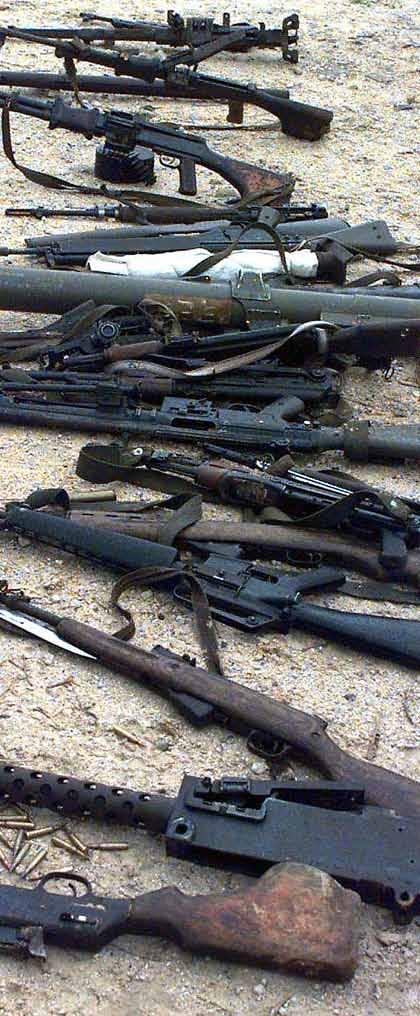
The intervening decade has seen this regional tool’s legal basis firmly established and its operationalization achieved to the point that the CEWARN Mechanism is a continental benchmark.
In May 2011, the 10th Committee of Permanent Secretaries, representing the member states, asked CEWARN to develop a new strategy that would expand the thematic and geographic coverage of its work, strengthen its institutional capabilities, and extend its partnerships and coordinating.
We have spent the last nine months developing a Strategic Framework that will guide the Mechanism’s work in 2012-2019. But this is not a beginning: the Mechanism is transitioning from another strategic period in 2007-2011.
The major goal of the last strategy was to build conflict early warning and response structures; that of 2012-2019 is to utilize those structures more effectively on broader challenges in peace and security.
The two strategies are therefore part of an evolution to one day fully realizing the powerful mandate member states gave the CEWARN Mechanism in the Protocol that is in force and has been ratified by the majority.
The mandate: To receive and share information concerning potentially violent conflicts as well as their outbreak and escalation in the IGAD region; undertake and share analyses of that information; develop case scenarios and formulate options for response; share and communicate information, analyses and response options; carry out studies on specific types and areas of conflict in the IGAD region.


In line with this progress toward greater effectiveness, this framework posits the Strategic Outcomes sought in 2012-2019 as:
1. Utilization of CEWARN’s decision support tools in policy formulation and development.
2. Entrenching of early warning and early response in local, national and regional governance.
3. ‘Franchising’ of the CEWARN values, standards and benchmarks by global, regional and national institutions.
4. Communities, citizens, private enterprises, and officials in CEWARN’s areas of operation are collectively engaged in upholding human security.

5. Sustaining preventive response initiatives – particularly cross-border ones – that combine local and national ownership, and utilizing them to influence scaling and best practices.

6. Expansion in the monitoring and mapping of conflict and violence systems (typologies and geographic coverage).
7. Adequate financial and human resources to implement the strategy.
To successfully attain these Strategic Outcomes requires us to think systemically about the capabilities and approaches that must be in place and that will play a big role in the 2012-2019 period in guiding the strategy and its implementation. The logic and rationale that feeds our thinking is provided in more detail later, from that we were able to reach a number of clear imperatives that are critical to our success.
1. The ability to gather credible and sufficient data to turn into high quality analysis.

2. The skills to map and analyze violent conflict risks and responses from a complex systems perspective.
3. The ability to serve the appropriate decision-makers with robust risk and contingency assessments in a timely fashion.
4. The capability to effectively grow and evolve the network in line with the needs of preventing violent conflict and enabling successful response.
5. The competence to support on-theground projects that reduce risks of violent conflict or mitigate it, and promote scaling for widespread effect.
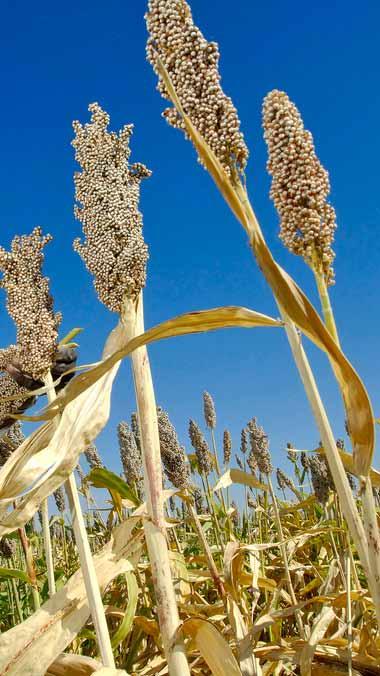
6. The use of an in-built learning mechanism that refreshes and reorients strategy and operations.
7. Outstanding facilitative and collaborative capabilities on the local, national and regional levels.
8. Clarity on standards and benchmarks driving partnerships.
9. An engaged network of peace champions.
10. A resilient/flexible financial position.

The progression above is an attempt to clarify the CEWARN process in the next 7 years, and reflects region-wide consultations.
The methods that were used are critical to its credibility and CEWARN’s future working style.
Knowing that the ultimate impact of peace building must be felt ‘on the ground’, CEWARN undertook to utilize a ground-up approach to developing the strategy.
• In the course of eight weeks at the start of 2012, CEWARN staff accompanied local experts and using a common guide, engaged with almost five thousand civilians and local officials in Djibouti, Ethiopia, Kenya, South Sudan and Uganda (The teams could not travel to local areas in Republic of Sudan due to the lack of existing areas of focus at the time, or to Somalia because of security risks.)
• Next were consultation meetings with national officials and NGOs in each member state.
• Finally in terms of consultation, the local and national results were compiled and visualized for presentation to a regional meeting made up of IGAD and member state officials, senior researchers, conflict analysts, and members of regional and international institutions.

• That regional conversation was visualized in real time as the almost sixty participants built up a vision of the CEWARN that the region required.

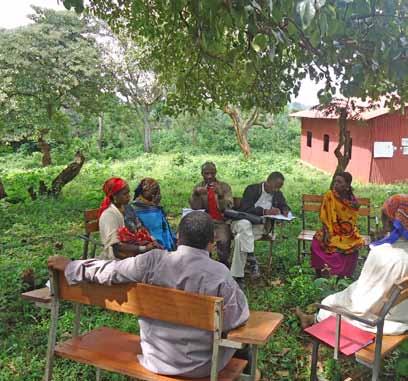
In the end, the results were taken and structured together into a draft strategic framework that was subjected to a validation and awareness meeting of member state, CEWARN and IGAD officials plus the primary civil society partners in July.
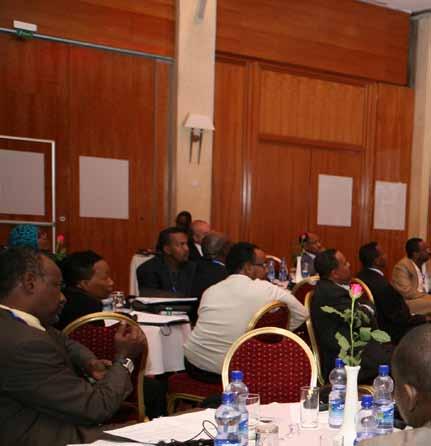





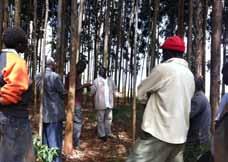
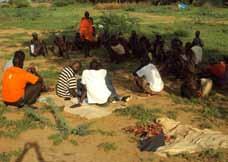
The Framework is a tool that forces us to think about our intentions in a logical and complete manner. It outlines the major choices and contexts that drive the work of the CEWARN Mechanism in a way that ensures the production of rigorous and emergent sets of wide-ranging decisions.
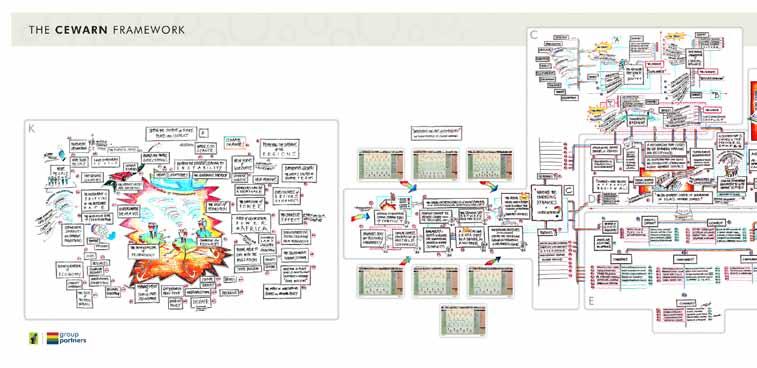
This is a framework built to evolve with the high priority needs for early warning and response that the member states and peoples will have during the life of the strategy.
It is an invitation: to all the components of the CEWARN Mechanism to unite around a regional vision but retaining the flexibility for national and local priorities to be pursued under a common approach.
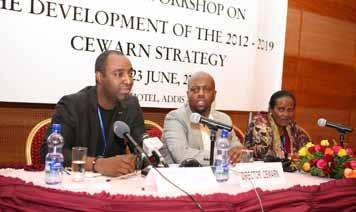
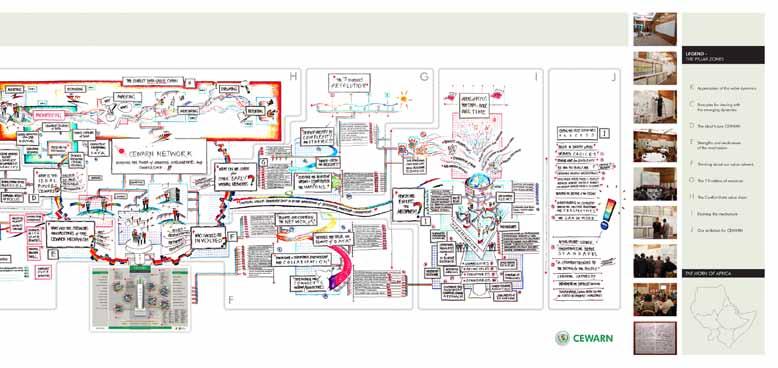
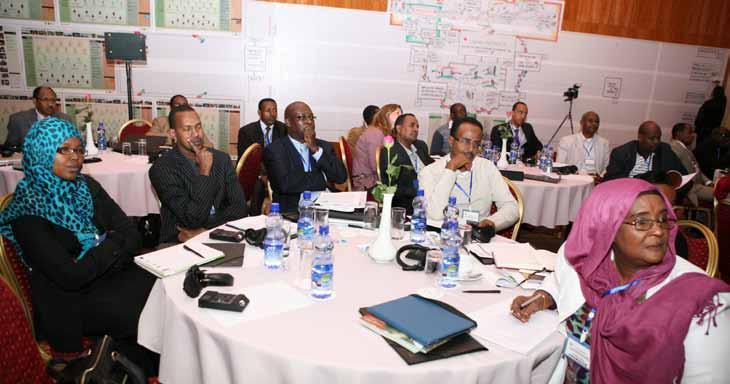

The context captured in this strategy framework can be told through this simple story...
The Big Prize that energizes all our work alongside our partners is to contribute to building ‘an IGAD region in which conflicts are resolved peacefully and justly and whose peoples live in shared prosperity.’ To make that journey in good order, we must constantly renew our knowledge of where we stand: in other words our Current Reality vis-à-vis existing and potential violent conflict and the way we operate as a network. The Strategic Outcomes achieved through 2012 -2019 will result in measurable change as we progress towards the Big Prize.
We will do so with the organizational assumption that ‘high quality, credible information and analysis on threats to peace and security and appropriate responses, delivered in timely fashion to the right individuals and institutions will lead to quality decisions that increase peace and security in the IGAD region.’
The Outcomes will be achieved through working within Strategic Pillars - that include organizational capability; communication and engagement; network capability; as well as research and analysis. This work in its operational and strategic dimensions will be continuously Monitored and Evaluated as a means to judge CEWARN’s progress in fulfilling its objectives, and ultimately its goal, through benchmarks focused on security; awareness; leadership; ownership and collaboration. To successfully journey from the Current Reality, realize these Outcomes and ultimately the Big Prize, there are Critical Imperatives that need to be in place for CEWARN to be successful. To attain them has implications to the way we work: these are the Operational Implications that will apply to the Mechanism as a whole as well as its individual institutions. Our work will be guided by an Implementation Plan that regionally and nationally may have different priorities but will be guided by the values, partnerships and approaches that make up The Strategic Framework.

Strategy at base is a story about traveling from the present to a major goal set in the future supported by a coherent rationale that guides choices and action
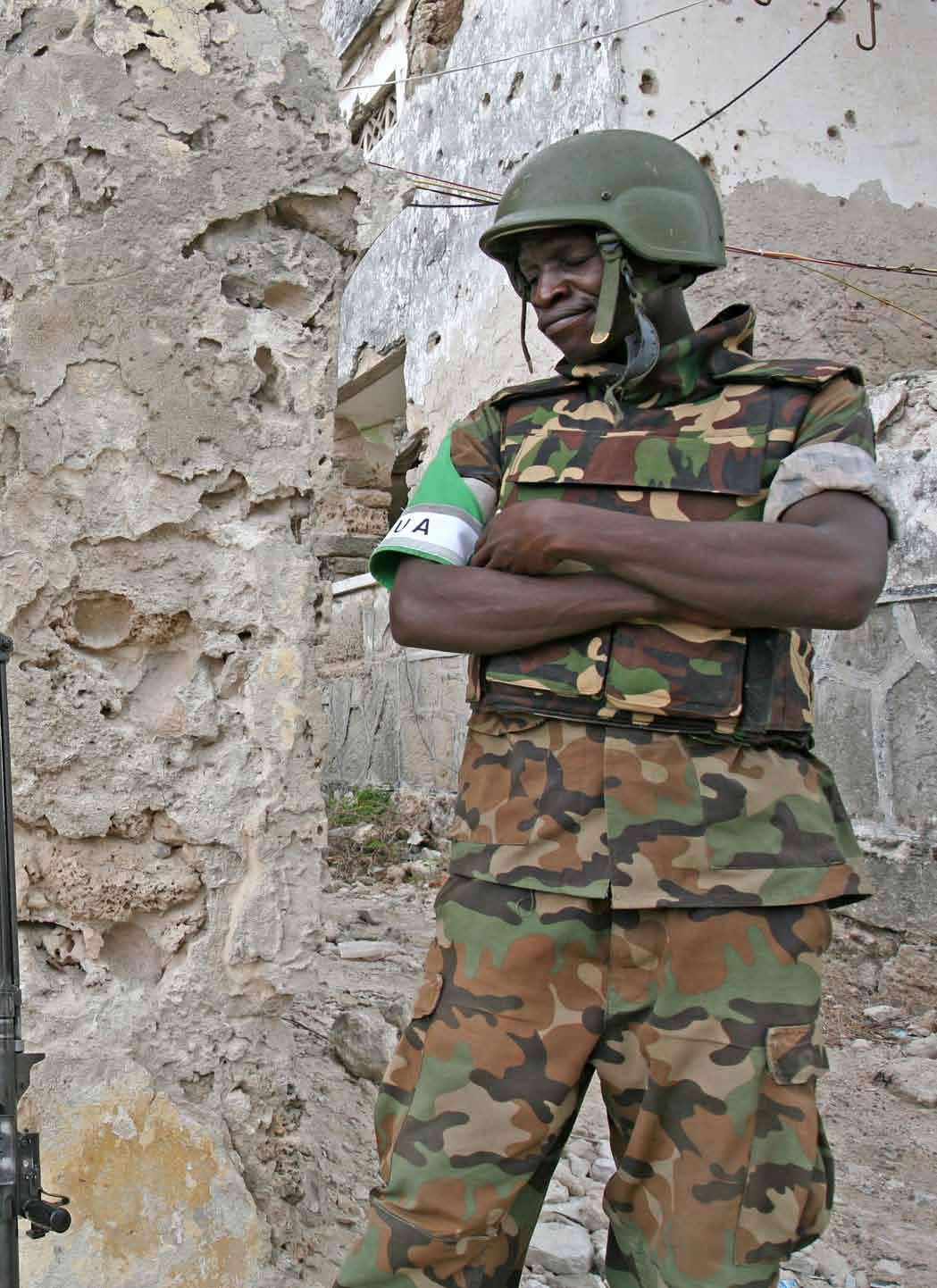
The Strategy Framework will strengthen CEWARN’s already useful work in extending the reach of conflict early warning systems on the continent.
In addition to being a constituent part of the African Union’s Continental Early Warning System, CEWARN will seek to partner strongly with the RECs whose members intersect those of IGAD: the Common Market for Eastern and Southern Africa (COMESA) and the East African Community (EAC).
The African Peace and Security Architecture (APSA) includes initiatives aimed at conflict prevention, management and resolution, as well as post-conflict reconstruction. APSA’s work is aligned to five pillars, one that is the Continental Early Warning System (AU-CEWS) that as mentioned above is linked to CEWARN.
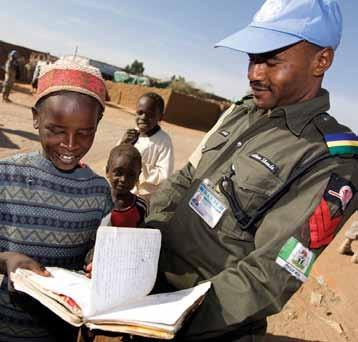
This architecture has received continuing endorsement in IGAD that most recently identified early warning as a major part of its Peace and Security Strategy.
CEWARN prioritizes coordinating with, as well as building, the capabilities of national early warning systems. This Framework therefore accommodates the national needs, interests, priorities and capabilities.


The IGAD region’s countries and peoples largely aspire to prosperity and security despite difficult socio-economic realities. Early warning of risks of violent conflict or its escalation is necessary if preventive efforts are to be taken that safeguard the region’s dreams of sustained peace and shared prosperity are to come true, and stay that way. This Strategy Framework consciously seeks to promote early warning and early response as critical bridges between the present reality and the bright future that the region’s people and governments seek.
The CEWARN Mechanism as a regional institution is particularly focused on promoting positive convergence, especially as reflected in the IGAD Minimum Integration Plan.
a
is required if these schemes are to live.
Sustained peace – and stability at
minimum –



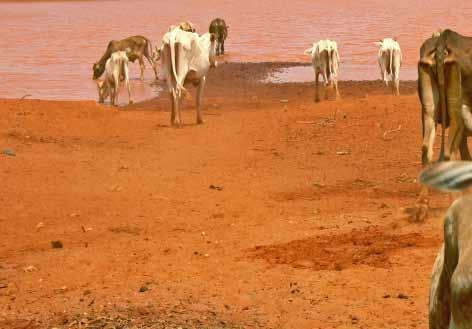
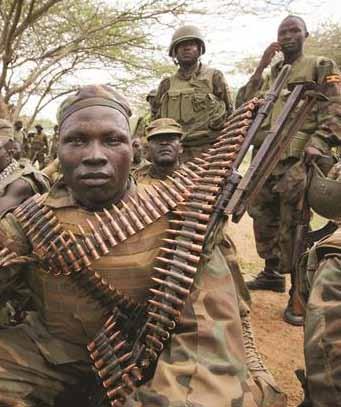
There are major structural forces that drive peace and insecurity in the IGAD region. They interact in highly complex and dynamic fashion, critically shaping the way individuals, communities and institutions respond to their environment.
Some of the major ones are:
1. The risks and structures of violent conflict are increasingly complex and interwoven.
2. Rapid urbanization and the conflict implications of the cities’ networks and proximities.
3. Climate extremes.
4. The growing nexus between resource competition and violent conflict.
5. Governance structures on the national, regional and international level lag the pace of socio-political change and evolution speeding up decision loops.
6. A large youth population that is difficult to absorb in the formal sectors of governance and economic life.
7. Growing populations and economic development have increased the demand for natural resources and contributed to environmental degradation.
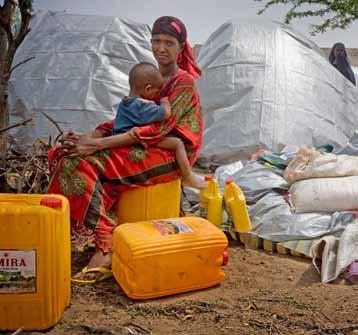

8. The socio-cultural values that inform cooperation, competition and conflict are increasingly divorced from long-standing traditions and are driven by ideals, appetites and worldviews from distant lands.
9. Historical inequality among regions or center–periphery conflicts in political and socio-economic terms.
10. The rapid evolution of communications and weapons technology and its democratization.
11. The rise of BRIC plus geo-economic, geopolitical power and non-state actors.
12. Major ideological categories (fascism, communism) are less relevant but there will be emergent ‘politico-cultural-social’ worldviews that drive behavior.
13. The need and difficulty in managing diversity in terms of identity - be it religious, ethnic, regional or class.
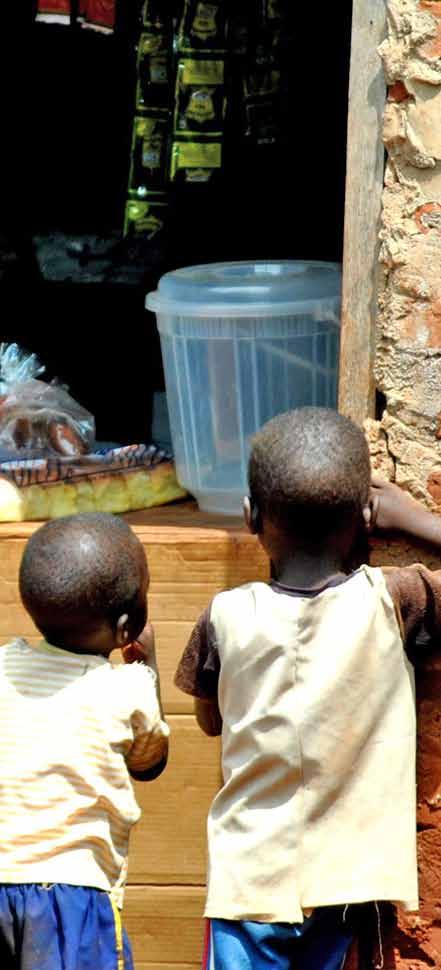
CThat energizes all our work alongside our partners is ‘to contribute to building an IGAD region in which conflicts are resolved peacefully and justly and whose peoples live in shared prosperity.’

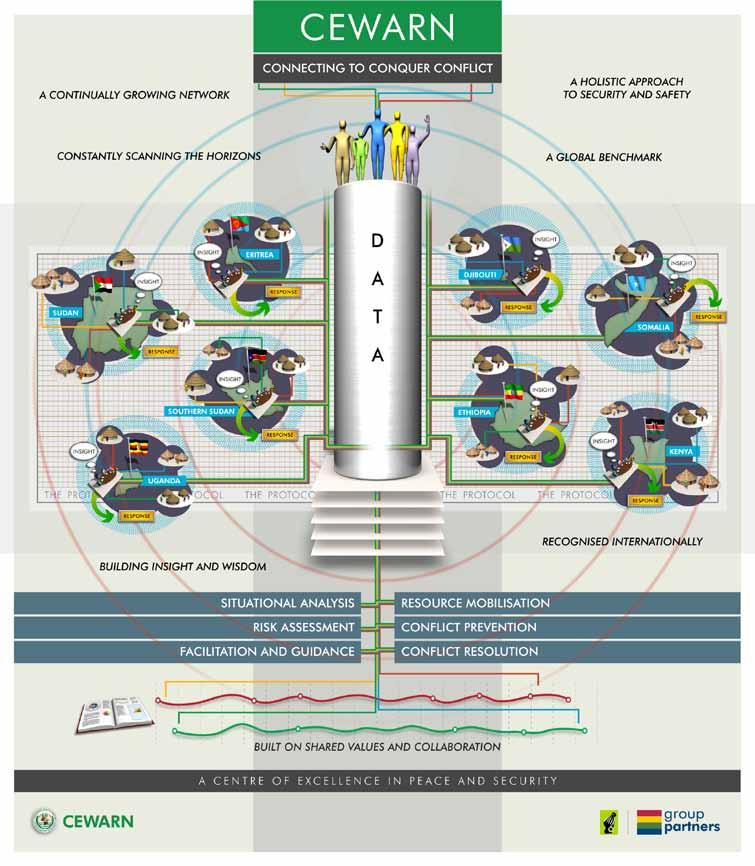
1. Region is increasingly faced with multiple and sometimes cascading hazards.
2. Decision making that impacts peace & security is not sufficiently evidence backed.
3. The analytical, communication and implementation capabilities of local and national institutions lag the challenges to peace.
4. Response systems lack the flexible and adaptive capabilities the complexity of violent conflicts in the region require for successful intervention.
In order to make the journey toward the Big Prize as critical contributors to its achievement, we must constantly renew our knowledge of where we stand: in other words it is crucial to understand the Current Reality of the IGAD region.
5. There is a gap in incorporating a learning and continuous improvement culture in conflict prevention and peace building institutions.
6. Lack of a systematic appreciation of the gender dimensions of violent conflict with due sensitivity to the diversity of the region.
7. The visibility and positioning of CEWERUS vis-à-vis conflict prevention and peace building policy formulation and implementation.
8. A poor understanding of how the CEWARN Mechanism can operate most effectively (lack of clarity on the value addition different parts of it need to deliver and the division of responsibilities).
9. A predominantly linear approach to preventing or mitigating violent conflict that often lags the complexity of society and relationships driving change.
10. The overall weakness in skills to consistently turn data into knowledge and use that to drive action lag.

1. CEWARN is part of regional and national peace building architectures.
2. Credibility won through a decade of work.
3. The linking of government, civil society is a critical innovation that will increasingly become a part of 21st century governance.
4. There is a political and social consensus on the importance of conflict prevention.
5. The institutional ability to link regional, national and local conflict prevention strategies and approaches.
6. A precious body of data and knowledge.
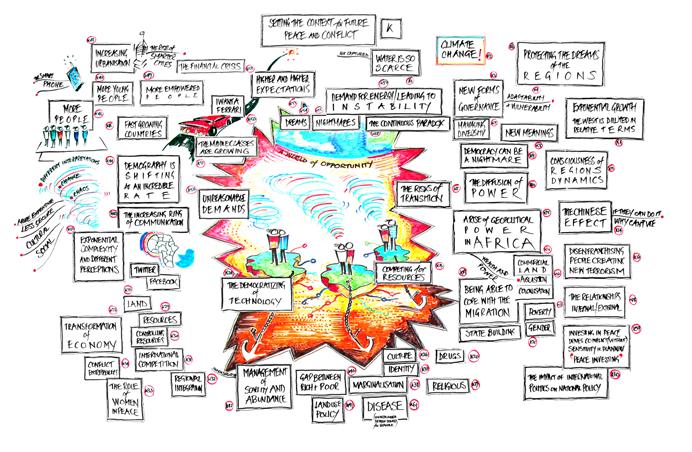
7. The ability to implement on-the-ground development projects that entrench peace by reducing the incentives for violent conflict.
8. Ability to work with international, regional and national research institutions and other sources of expertise.
9. Ability to have continued financial trust by IGAD and partners.
10. Goodwill of donor partners.
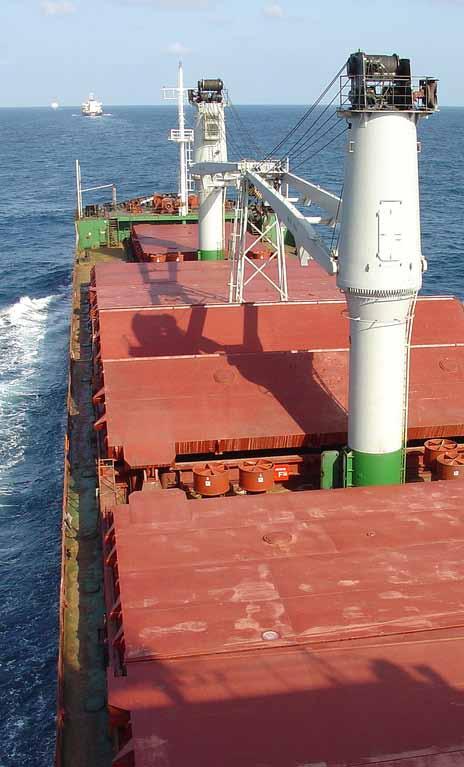
The Strategic Outcomes achieved through 2012-2019 should result in a measurable change as we progress towards the Big Prize.
The Strategic Objecives are:
1. Utilization of CEWARN’s decision support tools in policy formulation and development.
2. Entrenching of early warning and early response in local, national and regional governance.
3. ‘Franchising’ of the CEWARN values, standards and benchmarks by global, regional and national institutions.
HThe overall goal for the 7 year period that underlines that change is for CEWARN to be a network of excellence that works to advance an IGAD region in which reducing the risks of violent conflict through structured and consistent early warning and early response is central to local, national and regional governance in the Mechanism’s priority areas of intervention. This attained primarily by developing decision support and evaluation tools for decision-makers on the local, national and regional levels that allow them to make decisions that prevent or mitigate violent conflict and lead to effective response initiatives. The success of CEWARN in achieving this overarching strategic goal is dependent on the extent to which the Strategic Outcomes are achieved.
4. Communities, citizens, private enterprises, and officials in CEWARN’s areas of operation are collectively engaged in upholding human security.
5. Sustaining preventive response initiatives –particularly cross-border ones – that combine local and national initiative, and utilizing them to influence scaling and best practices.
6. Expansion in the monitoring and mapping of conflict and violence systems (typologies and geographic coverage).
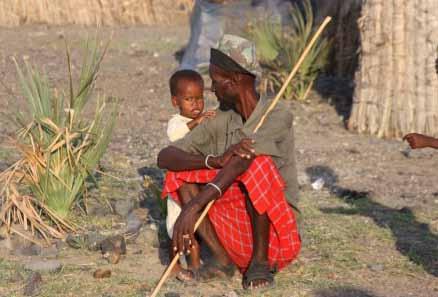
7. Adequate financial and human resources to implement the strategy.

CEWARN’s major working assumption or its Theory of Change is that it can achieve these strategic objectives through the provision of…high quality, credible information and analysis on threats to peace and security - delivered in timely fashion to the right individuals and institutions to aid in policy and operations decision-making.
That is to say that decisions driven by quality data and knowledge over time - even if not all are correct as is the case with all decision-making - will over time produce increased peace and stability in the region.
The Theory of Change assumes that the Mechanism will operate on the principles of timeliness, transparency, cooperation, broad consultation, and the free flow of information.

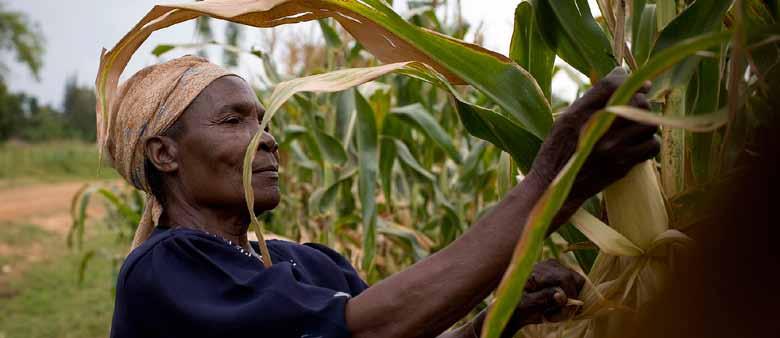
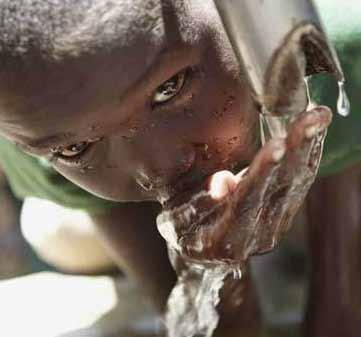
1. The ability to gather credible and sufficient data to turn into high quality analysis.

2. The skills to map and analyze violent conflict risks and responses from a complex systems perspective.
3. The ability to serve the appropriate decisionmakers with robust risk and contingency assessments in a timely fashion.
To successfully close in on these Strategic Outcomes, and thus close the gap between today’s reality and the future we want, there are Critical Imperatives that must be in place.
4. The capability to effectively grow and evolve the network in line with the need for preventing violent conflict and enabling successful response.
5. The competence to support on-the-ground projects that reduce risks of violent conflict or mitigate it, and promote scaling for widespread effect.


6. The use of an in-built learning mechanism that refreshes and reorients strategy and operations.
7. Outstanding facilitative and collaborative capabilities on the local, national and regional levels.
8. Clarity on standards and benchmarks driving partnerships.
9. An engaged network of peace champions.
10. A resilient and flexible financial position.
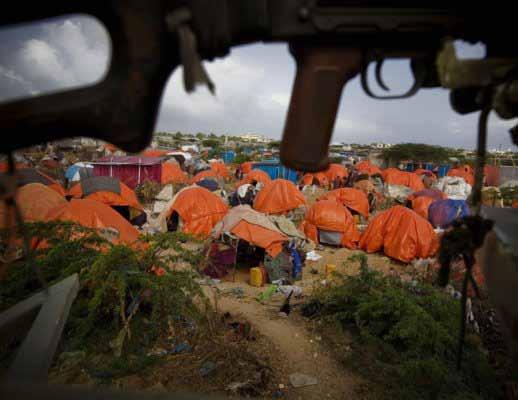
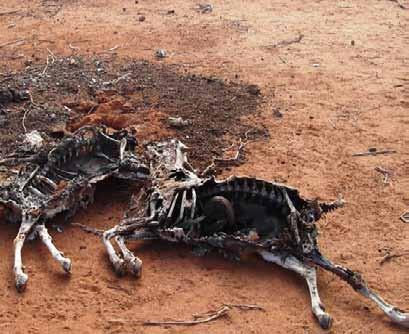
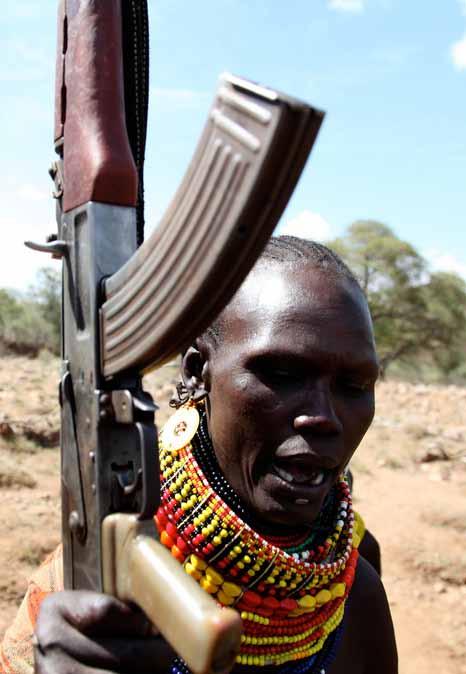
DThe Outcomes overleaf will be achieved through working within Strategic Pillars. A primary piece of our equipment is our knowledge of the data and where and how that informs high quality decisions across the Value Chain. The implementation of this strategy will be based on the following strategic pillars.

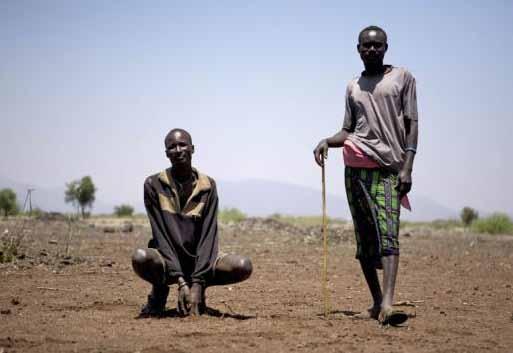
There were broad areas of convergence in prioritization between and within member states about the kinds of violent conflict risks but there are differences owing to the diversity within the region. The overall demand has been for substantive expansion in the types, themes, causes, drivers and triggers of violent conflict and where geographically they are covered. Expansion will be in line with Member States’ stated priorities and demands.
A key outcome of the national and regional consultations was the consensus that no single factor or driver necessarily leads to violent conflict.
Opposite is the table of priority conflict typologies that emerged from rigorous discussions between government officials and experts. In addition to these, different drivers, triggers and promising response interventions were identified all that will be part of operational planning and implementation.
Djibouti
• Inequality
• Entrenching peace through curriculum development and delivery
• Gender-based violence
• Murder/killing – inter-personal, intra/inter-group (tribes, pastoral groups)
• Conflicts caused by environmental pressures/climate change
• Competition over resources
Ethiopia
• Border/territorial conflict
• Land grabbing
• Migration (In country and cross border)
• Terrorism (e.g., violent extremism)
• Inter-ethnic conflict
• Religious-based conflict
• Resource-based conflict (climate-driven conflicts; land related conflicts)
• Imbalanced development
• Violence between pastoralist communities and commercial cattle rustling
• Proliferation of SALW
• Drought
• Piracy
Kenya
• Elections violence and devolution
• Boundary and border disputes
• Land ownership
• Conflict sensitive development (Infrastructure, large-scale investment)
• Natural resource exploitation (oil, minerals, pasture, water…)
• Violence between pastoralist communities
• IDPs, Migration and Refugees
• Urbanization
• Organized crime
• Proliferation of SALW
Somalia
• Refugees and IDPs
• Clan based conflict
• Livestock rustling
• Control of trade and revenue routes
• Trade
• Resource-based conflict (minerals, scarcity of pasture and water)
• Land ownership and boundaries
• Food insecurity
• Climate change induced conflicts
Republic of Sudan
• Natural resources use and management
• Conflicts due to pressure from climate change
• Proliferation of SALW
• Land grabbing
• Land use and laws governing land
• Borders and boundaries
• Violence between pastoralist communities
Republic of South Sudan
• Child abduction
• Land ownership disputes
• Border and boundary conflicts
• Crime
• Violence between pastoralist communities

• Constitutional (statutory versus Customary Laws)
Uganda
• Land (conflicts arising from population growth, investment)
• Natural resource competition (minerals, oil & gas, forests, pasture, water)
• Violence between pastoralist communities (continuity/integrate with resource/land issues)
• Migration
• Border disputes (domestic and international)
• Election-driven violent conflict
• Negative ethnicity
• Migration (IDPs, foreign migrants, population growth, and people resettled through large scale investment and development projects)
• Environmental and climatic drivers
• Marginalization
• Food insecurity
D2. Organizational and Network Capability (CEWARN Unit, CEWERUs, Research Institutes, and other primary and secondary partners)
Without the CEWARN Unit, CEWERUs, research and implementation partners having strong capabilities in administration, analysis, advocacy and accountability, the Mechanism as a whole will struggle to attain its Strategic Outcomes.

Network engagement and communications will remain priority areas of CEWARN’s operations going forward. They will also be embedded in all aspects of its operations as the mechanism is built on an interwoven network of institutions that operate at local, national and regional levels.

Expansion of conflict themes, typologies, drivers and triggers needs to be done within an acknowledgement of the complexity of the IGAD region and its individual countries. Analysis that is linear will struggle to keep up with the enormity of the task in this diverse and dynamic region. There are important principles that emerged from the consultations that need be at the heart of future analytical capability and skill building throughout the Mechanism:
• That the IGAD region, and indeed the world, is marked by complex social, economic, cultural, and political systems and actors within them that are interdependent and interconnected in system-wide actions emerging continuously from interactions among the different actors/groups.
• That change processes - whether political, economic or social - are evolutionary and can have tipping point that shift them extensively in non-linear fashion.
• Societies are complex human systems in constant in flux as individual and group actors adapt and interact with one another and their ecosystem in pursuit of their perceived interests and worldviews.
• ‘Ground truth’ is a critical component of analysis as it is combined with more structural and aggregated data sets; this combination will set the CEWARN Mechanism apart from other networks working in conflict prevention in a way that adds to its relevance and credibility.
Bringing these principles to life will require building adaptive capabilities into operations, and develop and deploy skills in analyzing and mapping complex systems.
The response initiatives, similar to research and analysis, cut across our work. This will involve strengthening the rapidity of response interventions as well as sequencing early warning with real-time response.
CEWARN will aim in the coming strategic period to become a learning organization. Lessons learned, new knowledge identified will be constantly fed back into the Strategy Framework and operations. The most important tool in this will be developing and deploying a robust monitoring and evaluation system rooted in participatory approaches and simplicity.
In order for CEWARN to meet the objectives of the strategy, a reliable and comprehensive resource base is necessary. The Mechanism will need to encourage Member States to increase their financial and in-kind contributions, in addition to cultivating new funding sources. Running through each of the above strategic pillars will be a component of the following two cross cutting themes that will be embedded into our plans and actions and will heavily influence the changes that we make to the operating model as a result of this strategy.
CEWARN aims to master the data value chain. At the heart of the Mechanism is data which is its most precious resource and the foundation of its leading assumption: that ‘high quality, credible information and analysis on threats to peace and security and appropriate responses, delivered in timely fashion to the right individuals and institutions will lead to quality decisions that increase peace and security in the IGAD region.’
Although the outcome(s) of quality decision may take time to be manifest, CEWARN will work towards ensuring that, among other considerations, decisions made towards addressing peace and security issues in IGAD region are as much as possible evidence driven, aware of several credible possible scenarios and consequences of response or non-response.

FTo successfully pursue the Strategic Pillars has implications for how we work. We call these the Operational Implications.
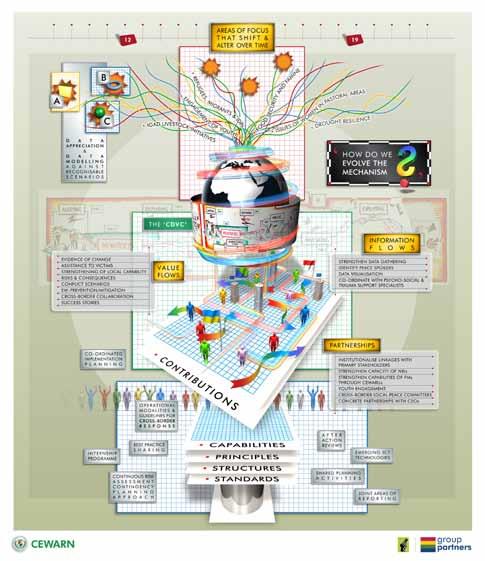
1. A broad spectrum of skills and professionals will need to be recruited and deployed.
2. A Facilitator Corps of trained personnel in local, national and regional facilitation will allow the Mechanism access to individuals who can be dispatched to map actors, promising response initiatives and impact. From this corps of individuals with different languages and professional skills will come the flexibility that this strategy requires from the Mechanism if it is to succeed. They will provide the ‘ground truth’ that ensures that early warning and response initiatives on the national and local level are well informed and credible.
3. Ability to acquire and transfer skills in a structured fashion throughout the Mechanism and to partner institutions.
4. Ability to integrate diverse and complementary data sets in analysis, decision support, and implementation.
5. Ownership clarity: regional value addition by the CEWARN Unit; ownership of the national data collection and response by the CEWERU committee and its member institutions.
6. Joint planning (including reachable timeframes) across the CEWARN Mechanism (Unit, CEWERUS, policy organs, IGAD Secretariat).
7. Convening of policymaker forums to fashion needed operational, policy and legislative solutions in anticipation of violent risks emerging from social, economic and political conflicts.
8. Deploy a structured Mechanism-wide learning process that allows for operational corrections, lessons learned and after-action reviews.
9. Sufficient financial resources.
10. Identify and implement common best practices on CEWERU visibility, positioning, and effectiveness.
11. Including gender, and youth specific issues and concerns in planning and implementation.
12. Promote active participation of marginalized groups in peace and security issues.
13. Operational systems able to engage productively with responders to make their decisions and implementation more effective.
14. The Mechanism (especially the Unit and CEWERUs, has an improved ability to monitor and evaluate its performance.
15. Joint branding and brand management of the Mechanism.

EGiven the regional peace and security needs, the context and the current reality within which to implement this strategy, CEWARN has made critical choices on things that it will Start, Stay (Continue) and Stop doing.
Here is a partial list...
START:
• Expand conflict themes and geographic coverage in line with national priorities identified in the strategy development process and evolving from future national policymaker forums.
• Collaborate with relevant IGAD programs and the newly created Drought Resilience Platform to build resilience and prevent conflict1
• Institute a continuous learning approach that allows flexibility in strategic and operational processes.
• Integrate ‘complex adaptive systems’ in early warning and response analysis and initiatives.
• Communicate information clearly and effectively through graphical means- Information graphics, information visualization, scientific visualization and statistical graphics.

• Use of statistical and software tools to determine and predict policy outcomes across several sectors.
• Promote a shared understanding in addressing peace and security issues in the region.
• Popularize the 2012-2019 strategy at all levels to promote ownership and buy-in.
• Prioritize engagement of policymakers at national and regional level.
• Integrate gender in early warning and response research, analysis and operations.
• Add innovative approaches to our existing research fundamentals.
• Expand CEWARN Unit’s skills resources to meet the requirements of the strategy.
• Collectively build a positive and visible brand for the Mechanism.
• Encourage and support CEWERUs to raise funds to implement joint operations.
• Build collective responsibility to ensure ownership of the mechanism.
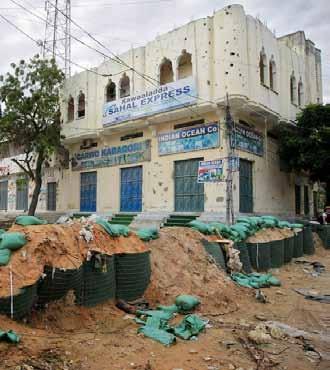
• Support Mechanism-wide development of operational plans based on the Strategy Framework.
• Fully deploy the M&E system and automate it where appropriate.
• Collecting data on local and national violent conflict, response initiatives and actors.

• Maintaining shared aims and initiatives among member states and within the Mechanism.
• Support the formulation and implementation of bottom-up approaches.
• Utilizing cutting edge technologies to improve early warning and response information & knowledge flows.
• Strengthen cross-border conflict prevention initiatives.
• Enhance networks of early warning practice on the national, regional and continental level (especially strengthening links with AU-CEWS, EAC and COMESA).
• Integrate relevant customary early warning and conflict prevention practices into CEWARN Mechanism.
• Developing the skill sets of CEWERU members, Field Monitors, and Country and Assistant Country Coordinators.
• Linking brand development to high-level seminars relevant to early warning and response.
• Maintain and leverage the Mechanism’s mandate to seek financial resources.
• Strengthen financial systems and accountability standards for all institutions utilizing the Mechanism’s resources.
• Expand and strengthen CEWARN’s resource center.
• Supporting and Up-scaling Response Initiatives.
STOP DOING:
• Predominant focus on reacting to violent conflict (a “fire fighting” focus).
• Focusing only on the national to the exclusion of the regional dimension (a major value add is that we are a regional mechanism).
• Downplaying the regional role and importance of the Mechanism2
• Deploying ‘gender’ and youth i n analysis and response in an ad-hoc or marginal fashion.
• Constantly having ‘dialogue’ as the leading end product of almost all conflict prevention analysis.
1Central to this will be the development of the Facilitator Corps that will link up early warning conflict mapping to participatory learning in projects, to local and national M&E.
2Mechanism should be ever visible on the national level with CEWERU heads and CEWARN Unit working hard to maintain this visibility through ensuring that CEWARN Mechanism analyses and materials are appropriately branded when tabled to decision makers and forums.
The 2012-2019 Strategy Framework is the CEWARN Mechanism’s attempt to ensure that IGAD Member States are equipped with an innovative and potentially transformative early warning and response tool. This will be brought to bear on the ever-shifting contours of conflict, and rapidly changing economies and technologies.
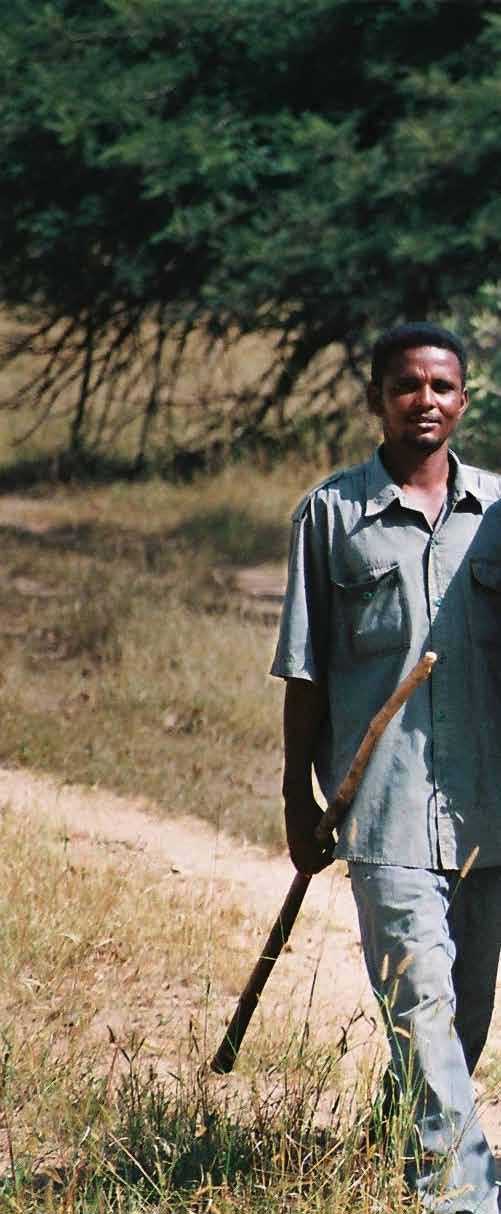
The decision loop on the local and national level has speeded up dramatically. Decisionmaking more than ever before requires factual and analytically sophisticated support if it is to over time lead to the desired outcomes.
This Framework builds on the last decade of work but must now attract and groom new and diverse sets of skills, and to proliferate high standards of performance, efficiency and effectiveness.
In the course of implementing this strategy, it is anticipated that decision-maker communities within the IGAD Member States will be availed high quality conflict early warning and response analyses in a timely and user-compatible mode.
By re-visioning our work in this style and at these two broad levels, we strive to be an institution that combines methods drawn from traditional conflict analysis with new and emerging tools to support comprehension of a complex environment. Pursued to operational reality, this Framework will be a path-breaking one that allows the Mechanism to make a positive contribution in eliminating leading threats to regional cooperation, peace, security and stability; and to secure for all freedom from want and fear.
This will undoubtedly be a daunting enterprise. In order to confront a battery of complexities, CEWARN will partner with a wide-ranging spectrum of specialized and non-specialized interlocutors within the African continent and further afield.
This process of interaction and ceaseless introspection is a crucial step in assembling a system that is able to adapt to new actors and interactions as they emerge, take advantage of available decisionsupport tools and, above all, embed early warning and response ideals and principles within governance institutions across the region. Furthermore, this multi-actor process of interaction will help to clarify our implementation roadmap, nurture synergies with other similarly situated organizations, and build networks at the national, local and regional level. As envisioned in the CEWARN Protocol, our highest ambition with this Strategy Framework is to upgrade our vigilance and preparedness for the region’s pressing risks of first-time and escalating violent conflict.

